St. Joseph River Steelhead Fishing: Guide Tactics and Tips
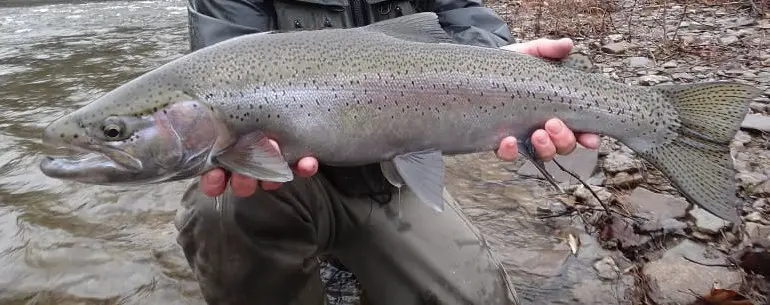
The St. Joseph River in Michigan is unique because it gets runs of steelhead all year long thanks to a summer run steelhead known as a Skamania. The St Joseph River steelhead fishing peaks in late fall and spring and anglers can fish the river by foot or by boat.
Where Is the St Joseph River
Located in Michigan, the St. Joseph River is among the largest rivers in the area with prolific runs of salmon and steelhead.
This river, which is in the north-central of the United States, starts near Hillsdale and flows to the west, then swings into northern Indiana through South Bend and Elkhart before reentering Michigan state.
The St Joseph River is a 206-mile-long river and is dammed at Union City in Michigan for hydroelectric development. It is also vital for industries and urban centers since it’s a significant water source in the area.
Steelhead, salmon and migratory Great Lakes brown trout can traverse some of the dams along the river, but their migration stops at Mishawaka, Indiana.
About St Joseph River Steelhead
The Skamania steelhead, which is a summer run steelhead, is stocked in this river and they can be found in the St Joseph River from early summer month to April, which provides a unique warm-weather fishing opportunity for steelhead anglers looking to catch some steelhead in the summer.
If the river becomes too warm for the summer steelhead, they will often hold at the mouth of cold water tributaries of the St Joseph river or they will move up into these tributaries during the warmest water periods.
Thousands of steelhead enter this river each year starting in the fall and continuing into April, making the St. Joseph River a great steelhead fishery regardless of your fishing experience or the methods that you use.
Although there is a summer steelhead, the St Joseph River is better known for its fall and spring runs of steelhead that enter the river in good numbers, with tens of thousands of fish entering the river.
Fishing for St Joseph steelhead allows anglers a chance to catch many steelhead in a day that average 5 to 6 pounds, but steelhead over 20 pounds have been caught from this large river.
The St Joseph River Steelhead Fishing Experience
Commonly known as St. Joe River, much of the lower river is wide and deep, with moderate to slow currents.
In some areas, it flows faster. This river can’t be waded easily in many sections so bank and boat fishing is common.
The river can get deep fast, so anglers wading should do so cautiously.
In the video, you can see a lot of forested banks and deep water close to the bank, but there are some good sections for wading too.
Steelhead fishing by boat is very popular. Small hard bottom motor boats, drift boats, or inflatable boats are a great way to fish and access some of the best steelhead water on the river.
Large deep runs and pools are present throughout the length of the St Joseph River, and anglers are smart to look for areas around islands and bridges where the fish will push to one side and concentrate.
The St Joeseph River has several dams near the towns of Berrien Springs and Niles. These can be great spots for fishing because these areas will concentrate steelhead. Check out spots like Fisherman’s Haven.
These dams contain fish ladders that enable the upstream movement of the steelhead and salmon to the city of Mishawaka Indiana, which is the upstream limit for migratory fish. But many fish will concentrate above and below the dams.
Some tributaries of the St Joseph River, such as the Pipestone Creek, the Dowagiac River, and Brandywine Creek, provide good wading opportunities for steelhead anglers and are good options when the main river is flowing too fast and too high to fish. The mouths of these tributaries can also attract many steelhead.
These tributaries are also easier for anglers to wade which makes for a better steelhead fishing experience.
These tributaries will see runs of steelhead, and salmon when the water flows in the streams are high enough for the fish to migrate up them. Some of these tributaries will also have some resident trout in them.
Summer Steelhead Fishing On The St Joseph River
The St Joseph River has been stocked with hundreds of thousands of Skamania strain Steelhead which is a summer-run steelhead. The river is famous for these summer-run steelheads, which you don’t often see on other rivers around the Great Lakes region.
Some Skamania will enter rivers as early as May and continue through to September which can provide a unique summer fishery for river anglers.
The St Joseph River gets one of the largest runs of Skamania steelhead, making it the best summer-run steelhead river in Michigan.
Skamania are known to be one of the strongest fighting fish, with long bodies and very large powerful tails.
The Skamania steelhead that enter the river in May, June, and July will often migrate from the St. Joe River into the colder tributaries if and when the main river gets above 67 degrees. They will often hold over in these tributaries through the warmer months.
These cooler tribs will often be where the steelhead will also spawn, and anglers can often find big steelhead mixed in with resident trout throughout the summer months.
Steelhead Fishing Methods
Although St. Joe has great steelhead runs throughout the river, anglers should fish areas that are 8 to 12 feet on average for the most success with steelhead and salmon.
Some river guides find the slower current areas to be the best. In addition, you need to position your boat well above the logjams and other structures and then directly lower your baits down to the structure. Using spawn bags and working lures around the structure tends to work well.
The best lures for St. Joe steelhead fishing include flatfish, wiggle warts, and hot-n-tots. To learn more about the best lures for river steelhead fishing, check out my page on Best Lures For Steelhead.
Fishing Methods For St. Joseph River Steelhead
Spin Fishing
Spin fishing is among the most popular fishing methods in this large steelhead river. Most anglers find it effective, especially when they follow the right steps and observe the different requirements, such as water coverage.
The spinning reel will allow anglers to cast far out into the bigger wider section of the river.
Common spin fishing techniques on the St. Joseph River include float fishing, casting lures, and bottom bouncing.
I normally use these techniques in runs, pockets, and shallow riffles since it’s often the most effective method in these spots.
Nevertheless, you can also use spin fishing methods like plunking and drift fishing in larger and deeper pools.
Plunking for steelhead is popular when fish are moving through and anglers that strategically place themselves along the river in areas that funnel the steelhead can do well with this method. For more on this method, click here.
Bottom bouncing is one of my favorite spring fishing methods when the fish are in shallower water or in pockets or around big boulders in the river. Here are some of the essential tips and tactics you can apply when executing the bottom bouncing technique.
Centerpin Fishing
Centerpin float fishing is very effective on this river because anglers can get very long smooth presentations with a Centerpin reel and a long 13 to 15-foot rod on this river.
The long rod also helps anglers control the steelhead and get them into the net.
Fly Fishing
Another popular and effective fishing method that you will find the fishing guides and anglers of the area using for St. Joseph River steelhead is fly fishing.
I prefer using the traditional indicator nymphing on the St Joe but I will often change to euro nymphing on its smaller shallower sections, and its tributaries.
If you like using fly fishing methods to catch steelhead, here is an article where I discuss the most effective guide methods for fly fishing for steelhead.
The use of slinkies and sinking lines is also common when fly fishing in this river during the winter period however, I find that indicators are a better option in the slower waters of the St Joseph River.
Fall Fishing For St Joseph River Steelhead
The St. Joseph River receives large numbers of steelhead and salmon throughout the fall season. In fact, migratory steelhead can be landed in this river twelve months of the year, but there are times when the fishing peaks.
Steelhead will often enter the River in September as the water temperatures start getting below 60f. Around the same time, anglers will also have runs of salmon and migratory brown trout.
The steelhead runs will often get bigger, and more fish will move into the river in late October, November, and early December.
This is a peak time and these are great months to be on the river steelhead fishing along with the other migratory species that are present in the river at this time.
Later in December as the river gets ice cold, the salmon disappear and the migration of steelhead will slow down or stop completely.
Winter Fishing The St Joseph River Steelhead
Winter steelhead fishing on the St Joseph River starts around early December, and continues to early March.
Getting your flies deep when fly fishing in the winter is important, but this is also when you need to get your baits down when float fishing and it’s when you also need to slow your lures down when lure fishing.
Float fishing allows anglers to get long slow drifts with their baits suspended just off the bottom and it’s even more effective during the cold winter months when steelhead are holding deep and won’t move far or fast for a bait.
Drift fishing is another method that works well during the winter months because it gets your bait deep.
When winter fishing, I always find that using smaller baits tends to be more effective. Anglers should do well with smaller spawn bags, pink plastic worms, flies like stonefly and mayfly nymphs, live or dead or plastic minnows, and beads.
Winter and cold weather can present challenges for most anglers when trying to catch steelhead which is why I recommend checking out my page Winter Steelhead Fishing: Tips And Tactics Of Guides.
Spring Steelhead Fishing On St Joseph River
Spring fishing for St Joseph River steelhead is often the best time to be on the river. As the water warms in early March, combined with snowmelt and rains, increased flows and the urge to spawn will bring in a lot of big steelhead.
I apply the same method that I use on many Great Lakes steelhead rivers in the spring. One thing for anglers to consider at this time of year with the increased flows is using larger baits at this time of year.
Large spawn bags that are the size of a dollar coin, large 4 and 5-inch plastic worms, and large flies like wooly buggers and white Clouser minnows can be most effective.
For more information on the best methods for spring, fall, and winter steelhead fishing, check out my article Steelhead Fishing – Most Effective Methods For Steelhead
Boat Fishing For St Joseph River Steelhead
Similar to many large river steelhead fisheries, boat anglers have the upper hand in fishing for steelhead on this river since they can fish a large portion of the river and get to spots the bank anglers can’t get to.
Boat anglers will do well at times with methods like side drifting with lures or baits. Boat anglers can also anchor and fish spots using methods like fly fishing with indicators or chuck and duck methods.
Boat anglers can also anchor and float fish or drift fish spots thoroughly.
The river has a few good boat ramps near the mouth and up the river, especially between the Berrien Springs and Lake Michigan.
Boaters can try launching boats at Shamrock Park in Berrien, the DNR boat ramp just off U.S. 31, and at the lower river, there’s a ramp near Exit 28.
If you’re a novice angler, hiring a guide on this large fishery will help you get the most out of it. Guides can teach you the best methods and the best spots and are often well worth the money.
What’s the Best Way To Access St. Joseph River for Steelhead Fishing?
St. Joseph River has numerous access areas along the river.
Since routes 31, 33, and 12 cross or parallel the St. Joseph River in sections, and you can often access the river in these spots.
You can also use access points such as bridges, parks, and trail areas along the river.
Best Fishing Reports for St. Joseph River
Whether you’re a beginner or an expert steelhead angler, you need current information on access points, water levels, temperature, and other conditions that may affect your fishing results.
The USGS website is one of the best river flow reports that you can refer to before you go and fish since it is accurate and is run by a reliable government body.
You can also find good flow information at SNOFLO. This report website provides gage information. They also give you access to rating information and a peak chart to help you determine which direction you should take and the most suitable fishing technique in that spot and season.
Steelhead Fishing Regulations
You need a fishing licence and there are some restrictions for certain areas and tributaries. And rules can change at any time. If you plan on fishing for steelhead on the St. Joseph River be sure to check the fishing regulations here.
Tight Lines
Graham

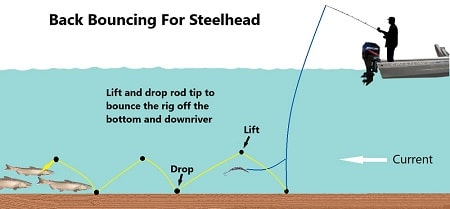
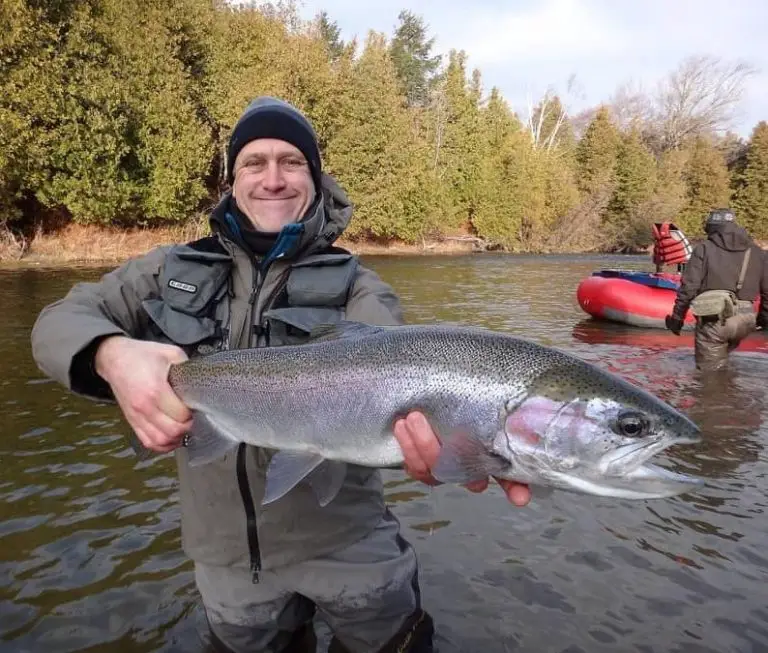
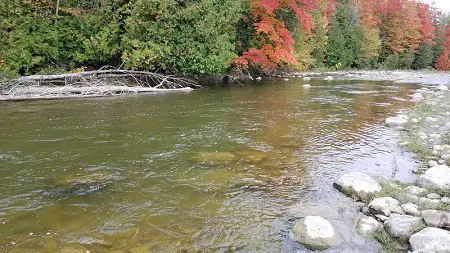
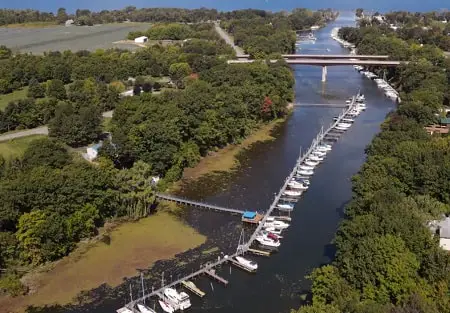
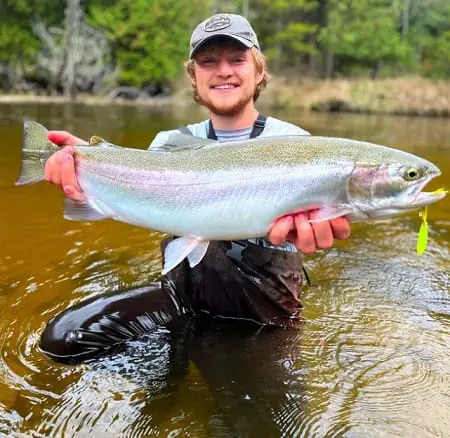
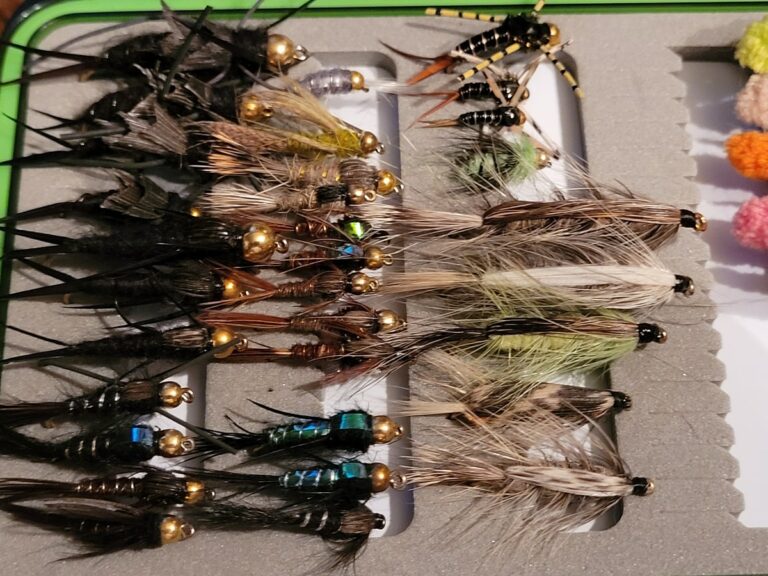
Are there any tributaries off the St.Joseph River in Indiana that can be fished by wading?
Hi Jeff,
You could try Pipestone Creek, Dowagiac River, and Brandywine Creek. May do an article on these rivers soon. Good luck,
Thanks Graham,I appreciate the feedback. Those rivers and creeks are all in Michigan which isn’t too far from where I’m located in Indiana. But wasn’t sure if there were tributaries in Indiana off the St. Joe that you were aware of. Again,thank you for the information.
Hi, Graham- I often fish the St. Joe for smallmouth bass (as well as the Paw Paw river and other creeks in the SW Michigan) but want to fish steelhead/trout also. I’d be interested in hiring you as a guide for a day while you are in the area. Please drop me a line if that’s a possibility.
Thanks-
Mike
Hey Mike,
It would be great to get out on the water with you, but due to other commitments I won’t be available to guide you for steelhead or trout this fall. Maybe check with Russ at https://www.fishseahawk.com/st-joseph-river-charters. They do very well with steelhead and have a ton of experience.
Good Luck,
Graham
is there a steelhead association that one can join? dies it give you access to both southwest Michigan and indiana fishing?
Hey Ronnie,
I’m not really sure, maybe someone else can help.
Graham